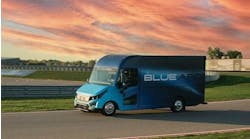This is Part 2 of our look at some of the top commercial vehicle engine trends on the way in 2024. Read Part 1 here.
Pickup engine trends
Emissions requirements also continue to impact lighter-duty vehicles. Case in point, tailpipe emissions requirements in CARB states are affecting both diesel and gas powertrains. “They’ve all had to get a bit cleaner to meet 50-state emissions requirements,” said Dave Sowers, head of RAM Commercial.
RAM Commercial has responded by replacing its entire powertrain.
“We will end production of our 5.7L HEMI engine for all of our light-duty applications,” Sowers said. “That is being replaced at the start of our 2025 model year, which is February 2024, with what we call our Hurricane powertrain.”
According to Sowers, Hurricane has been designed to meet customer demands for capability and efficiency while also satisfying emissions regulations.
“Hurricane represents a real inflection point for us in terms of engine technology,” Sowers said. “We’re going from a normally aspirated, overhead cam-type engine that was 5.7L to something almost half the displacement (Hurricane is 3L). But we’re getting higher output levels, much better fuel efficiency, and considerably lower carbon emissions.”
What’s unique about the Hurricane, Sowers pointed out, is that it’s an inline 6-cylinder with twin, low-inertia turbos. Each turbo feeds three cylinders to virtually eliminate turbo lag. Two output levels are offered. The high-output version provides 540 hp and 521 ft.-lb. of torque.
“That’s an incredible output level from a 3L engine,” Sowers said. Even the smaller version, at 400 hp and 450 ft.-lb. of torque, exceeds what RAM Commercial was getting out of the much larger HEMI engine the Hurricane is replacing.
RAM Commercial is introducing an all-electric ProMaster van in 2024. Sowers said electric light-duty pickups will be available in a few different formats: standard battery-electric, extended range, and a unique combination powertrain where a gas engine and generator are utilized along with a larger battery to achieve extended-range electrified operation.
Ford Pro is focusing on providing more options for its customers who require traditional gas or diesel powertrains. For example, the 2024 Super Duty truck has four engine choices, including the standard 6.8L V8 gas and a high-output 6.7L Power Stroke diesel V8.
“We have also doubled down on our commitment to hybrid leadership,” said Ted Haladyna, Ford Pro’s chief of product strategy and cross vehicle marketing. “In September, we revealed the 2024 Ford F-150 lineup, which includes the F-150 PowerBoost to give customers the capability they need.”
Of course, electrification is something that continues to trend strongly in the lighter-duty vehicle classes. Haladyna said there’s a growing business case to transition to EVs for many of Ford’s commercial customers. These include the E-Transit van and F-150 Lightning pickups. Expected benefits include lower fuel and maintenance costs, and greater uptime and productivity. Last year, the E-Transit saw a nearly 90% jump in sales from Q2 to Q3. Though Lightning sales have gone up, production volumes were cut in half to 1,600 per week to start 2024.
Natural gas and alternatives
Natural gas is another emissions-satisfying alternative fuel that is continuing to have a stronger impact with commercial vehicles.
“These engines are already certified at or below 2027 standards for Class 7 and 8 long-hauls,” said Walt Collier, commercial sector manager for Chevron. “Chevron actually offers a one-lubricant solution for a mixed fleet of diesel and natural gas engines, our Delo 600 ADF product.”
In addition to its updated X15 diesel, Cummins is introducing its X15N during the first half of 2024. With power ratings up to 500 hp and 1,850 ft.-lb. of torque, the X15N is a natural gas engine capable of meeting CARB and EPA regulations in both 2024 and 2027.
“We’re really excited about this because we think it offers some real opportunities for our customers from a sustainability standpoint,” Ulrich said. “Fleets now have the ability to run a 15L natural gas engine that matches the performance of a diesel engine.”
Ulrich said Cummins has had natural gas engines for decades, but those engines were often placed into specialized niches within the industry. This new X15N, on the other hand, is expected to catch on with a broader array of truckload carriers running typical routes.
Unlike previous natural gas engines from Cummins, which were ultimately “converted” diesel engines, the X15N features a cylinder head that is purpose-built for spark ignition. “That design allows the cylinder head to be optimized for the combustion phase profile and cooling passages,” Ulrich said. “That provides for improvements in spark plug durability and maintenance intervals. Additionally, having the option to use renewable natural gas, which is readily available throughout the U.S., gives fleets an opportunity to have a drastic reduction in carbon intensity.”
While the cylinder head is purpose-built for natural gas, most components below the head gasket are common with the X15 diesel engine, helping fleets minimize new hardware, support, and training needs.
The X15N is actually Cummins’ first engine emerging from what it calls its Fuel Agnostic Platform, where multiple engine versions are derived from the same base engine. In addition to natural gas with the X15N in 2024, Cummins is developing engines to run on hydrogen in the 2027-28 timeframe. Diesel will continue to be offered as well.
Of course, initiatives such as CARB’s Advanced Clean Trucks and Advanced Clean Fleets are designed to begin driving the medium- and heavy-duty truck industry more toward zero-emission vehicles (i.e., EVs) as well, beginning in 2024. “Initiatives like those are actually in lockstep with our overall corporate objective of carbon neutrality by 2039,” Detroit’s Copeland pointed out.
Even though 15 years may seem far away, it really isn’t. Companies like Daimler Truck North America, with its Freightliner eCascadia heavy-duty and eM2 medium-duty electric vehicles, have already introduced vehicles to help initiate that transition. But that doesn’t mean a more efficient diesel engine won’t continue to have its place. Likewise, alternative fuels such as natural gas and hydrogen will continue to evolve and find application. Yes, 15 years is still a ways down the road, but the pace is going to start picking up considerably in 2024.






